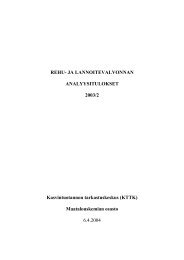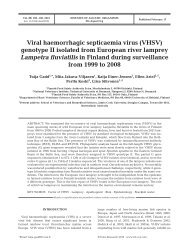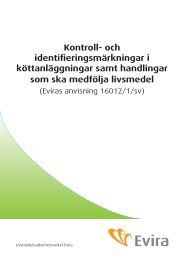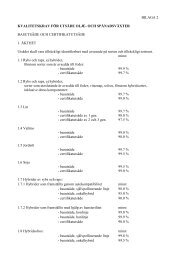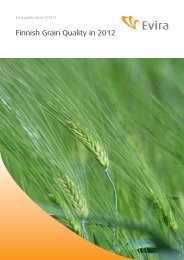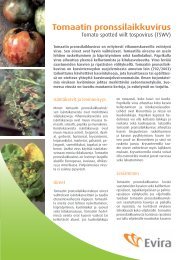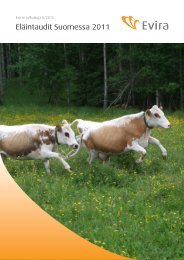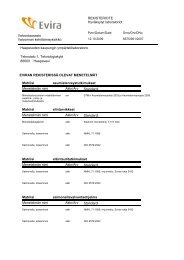Genetic characteristics of field and attenuated rabies viruses ... - Evira
Genetic characteristics of field and attenuated rabies viruses ... - Evira
Genetic characteristics of field and attenuated rabies viruses ... - Evira
You also want an ePaper? Increase the reach of your titles
YUMPU automatically turns print PDFs into web optimized ePapers that Google loves.
The nucleoprotein consists <strong>of</strong> 450 amino acids <strong>and</strong> participates in the transition<br />
from RNA transcription to replication. It encapsidates the positive-str<strong>and</strong> leader RNA <strong>and</strong><br />
prevents further transcription <strong>of</strong> the genomic RNA (Wunner, 1991; Yang et al., 1998) <strong>and</strong><br />
contains several antigenic <strong>and</strong> immunodominant sites. The antigenic sites I <strong>and</strong> III<br />
include stretches <strong>of</strong> amino acids at positions 374-383 <strong>and</strong> 313-337, respectively (Tordo,<br />
1996). One <strong>of</strong> the immunodominant sites is known to be located at position 404-418<br />
(Dietzschold et al., 1987; Ertl et al., 1989). Recently, the crystal structure <strong>of</strong> the <strong>rabies</strong><br />
virus nucleoprotein-RNA complex was determined (Albertini et al., 2006).<br />
The P protein is a phosphorylated protein <strong>of</strong> 297 amino acids, associated with the<br />
L protein to function as a noncatalytic c<strong>of</strong>actor for the RNA polymerization, <strong>and</strong> with the N<br />
protein to support adequate RNA encapsidation (Chenik et al., 1994, 1998; Jacob et al.,<br />
2001). Four additional proteins derived from the phosphoprotein gene <strong>of</strong> the <strong>rabies</strong> virus<br />
were also found to be present in infected cells, cells transfected with a plasmid encoding<br />
the wild-type P protein, <strong>and</strong> in the purified virus. It was shown that these proteins are<br />
initiated from secondary downstream in-frame AUG initiation codons. The P-gene is the<br />
only gene shown to encode more than one protein (Chenic et al., 1995). Two antigenic<br />
sites were found to be located at positions 75-90 (Tordo, 1996). The domain 83-172 was<br />
shown to contain the major antigenic determinants (Raux et al., 1997). An<br />
immunodominant site was also mapped in phosphoprotein at positions 191-206 (Larson<br />
et al., 1991), <strong>and</strong> was identified as the responsible alpha/beta interferon antagonist<br />
(Brozka et al., 2005).<br />
The matrix protein is a 202 amino acid polypeptide which plays a key role in virus<br />
assembly <strong>and</strong> binding. It covers the ribonucleoprotein (RNP) coil to keep it in a<br />
condensed form <strong>and</strong> was found to interact specifically with the glycoprotein (Mebatsion et<br />
al., 1999). The major antigenic site is located between the amino acid residues 1 <strong>and</strong> 72<br />
(Hiramatsu et al., 1992).<br />
The glycoprotein is a 524 amino acid protein <strong>and</strong> is the most studied protein <strong>of</strong> the<br />
<strong>rabies</strong> virus. It has a trimeric structure (Gaudin et al., 1992), with the first 19 amino acids<br />
representing the signal domain which is found only in nascent protein. The glycoprotein<br />
contains several antigenic sites <strong>and</strong> epitopes. The antigenic epitope I is represented by a<br />
single amino acid at position 231 <strong>of</strong> the mature glycoprotein. The site II is known to be<br />
discontinuous <strong>and</strong> involves two separate stretches between positions 34-42 <strong>and</strong> 198-200.<br />
The antigenic site III is located at position 330-338, epitope VI at position 264, “a” – 342-<br />
343 (Lafon et al., 1983, 1984; Seif et al., 1985; Prehaud et al., 1988; Bunschoten et<br />
11



